|
Worthgate Place
(Old Castle Yard 1824 ) (Castle Row 1838 ) (Castle Row 1838 ) )
Canterbury
01227 765091
https://www.whitehart-canterbury.co.uk/
https://whatpub.com/white-hart
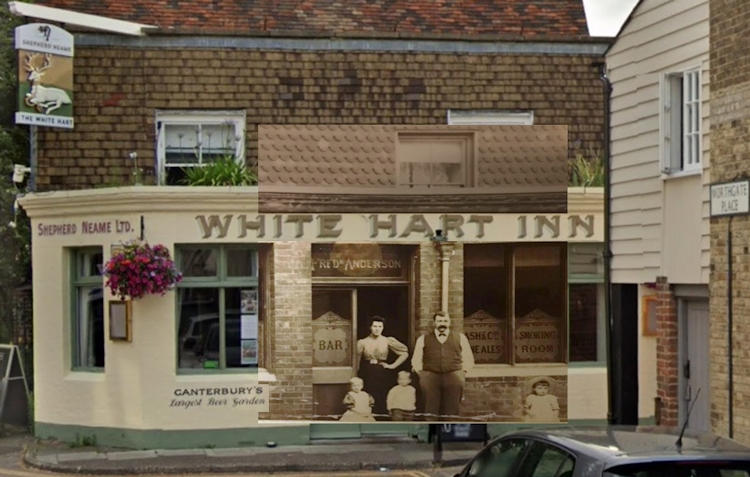
Above photo showing a 2024 picture montage with the Anderson family
standing outside (1900) kindly put together by Alan Smith. |
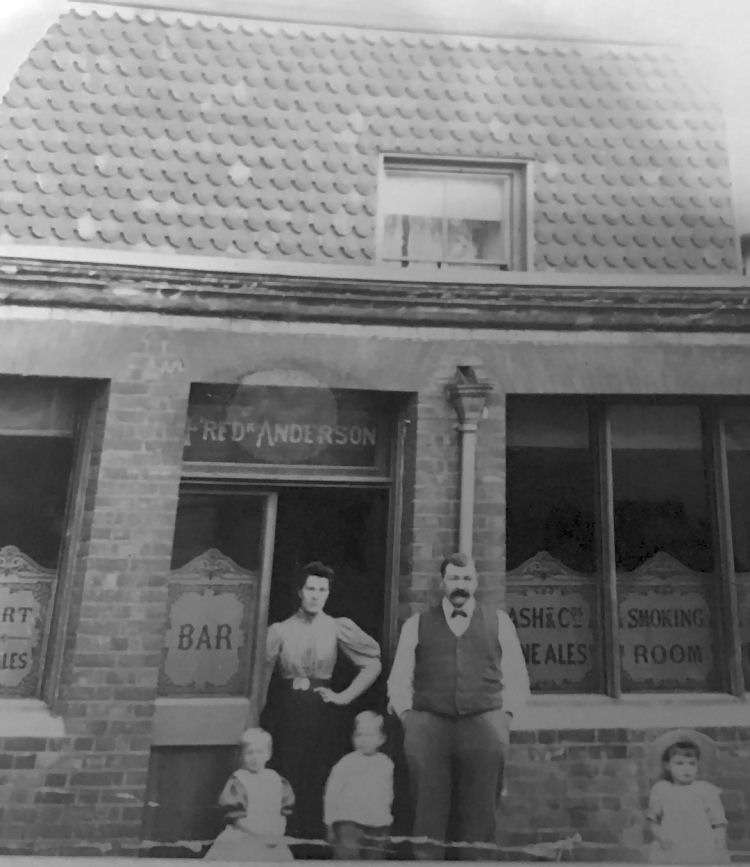
Above photo showing Frederick Anderson and family, circa 1900. |
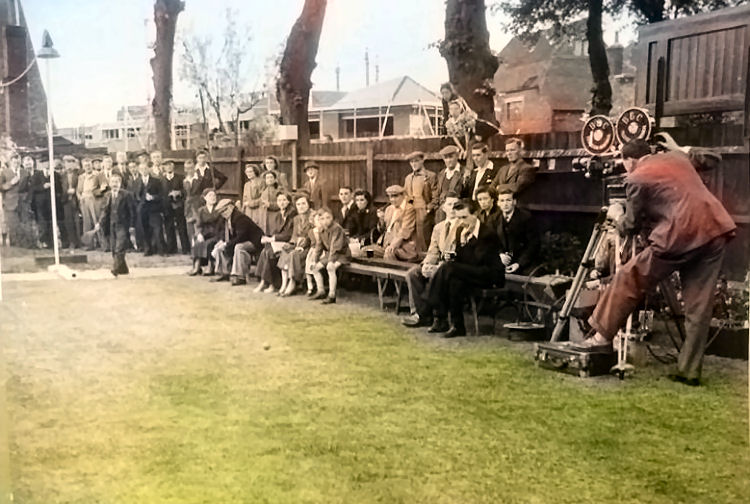
Above photo 1954, showing the BBC filming, kindly sent by Rory Kehoe. |
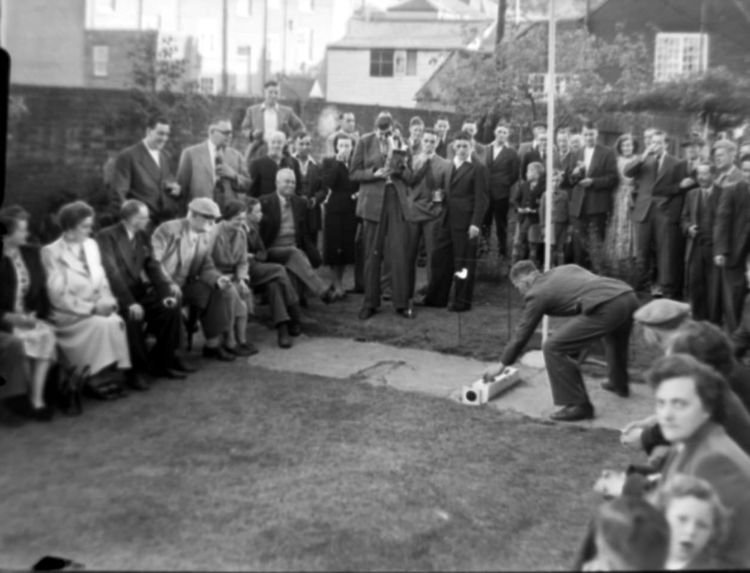
Bat and Trap game, date unknown. |
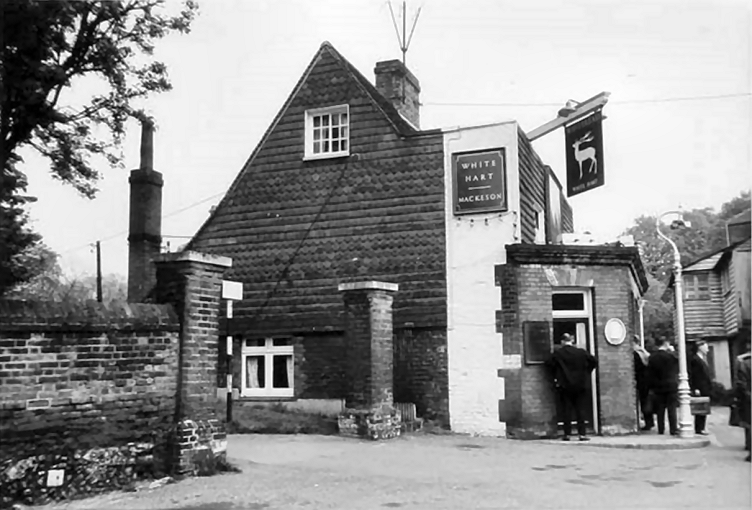
Above photo, 1961, kindly sent by Tim Timpson. |
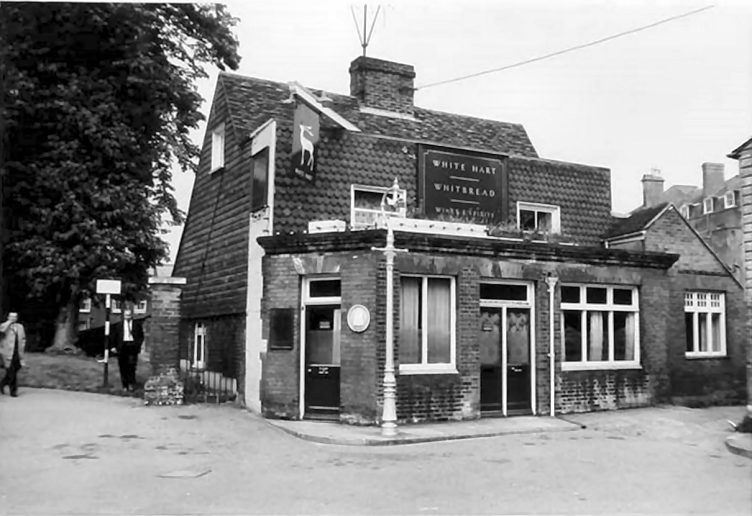
Above photo, 1961, kindly sent by Tim Timpson. |
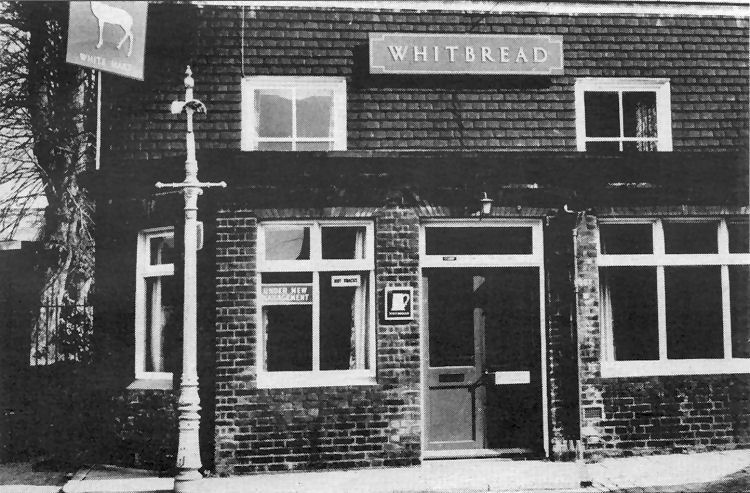
Above photograph taken by Edward Wilmot in 1965. |
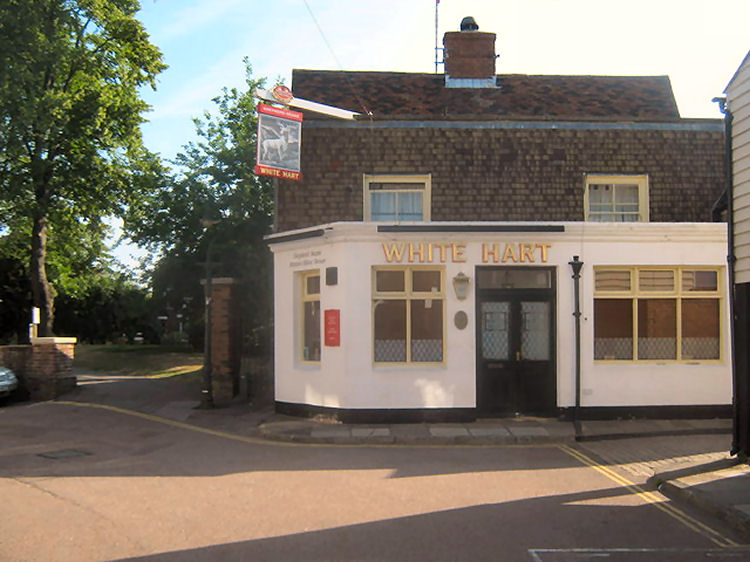
Above photo 2010 by David Anstiss
Creative Commons Licence. |
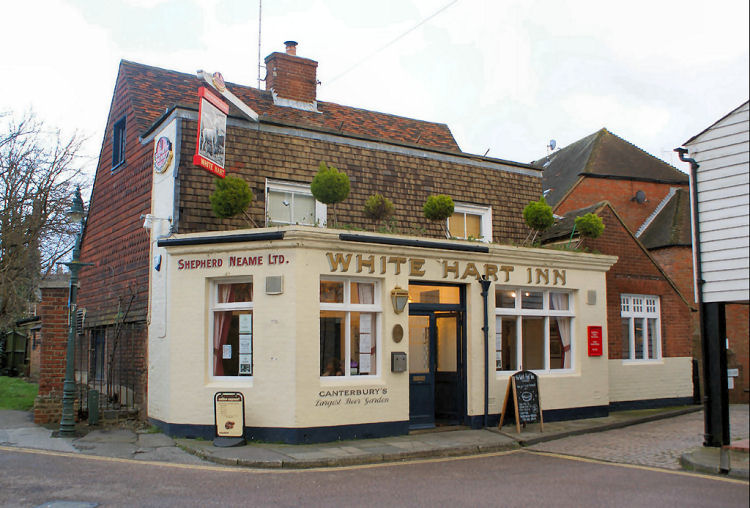
Photos taken in 16 January, 2014 from
http://www.flickr.com
by John Law. |
 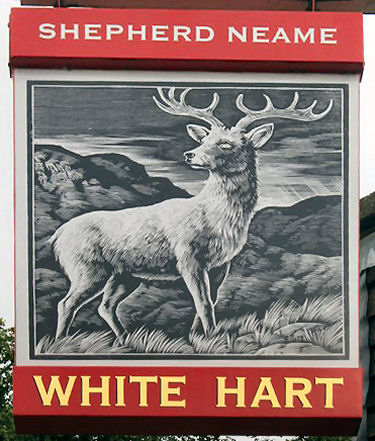 White Hart sign
left July 1991. Sign right 2010.
Above with thanks from Brian Curtis
www.innsignsociety.com |
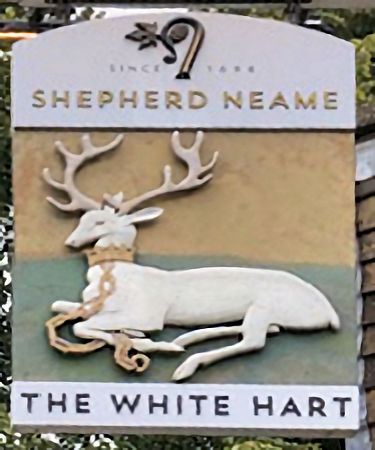
Above sign, 2024, kindly taken and sent by Michael Harris. |
 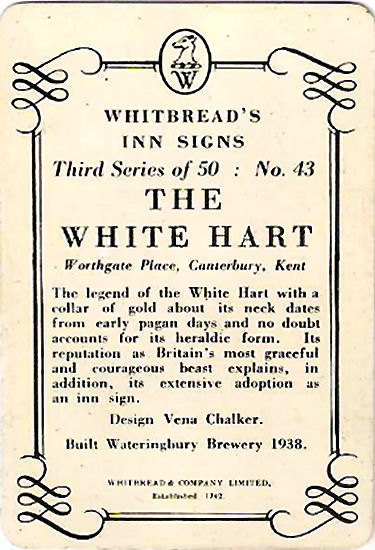
Above aluminium card issued June 1951. Sign series 3 number 43. |
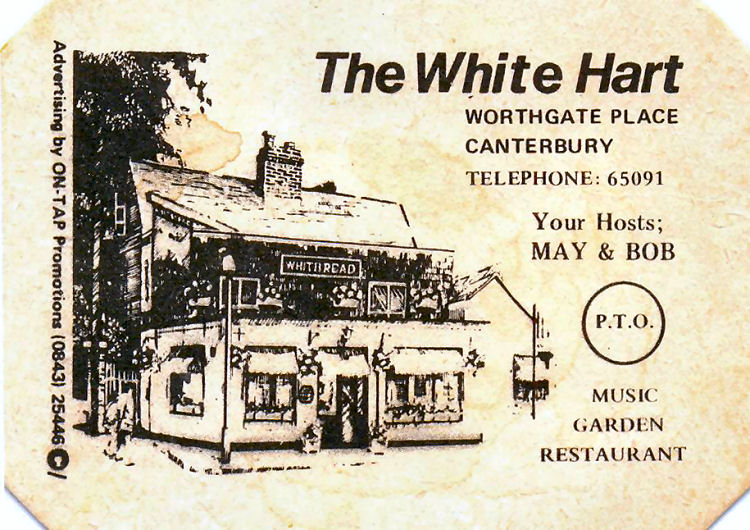
Above matchbox, circa 1985, kindly sent by Debi Birkin. |
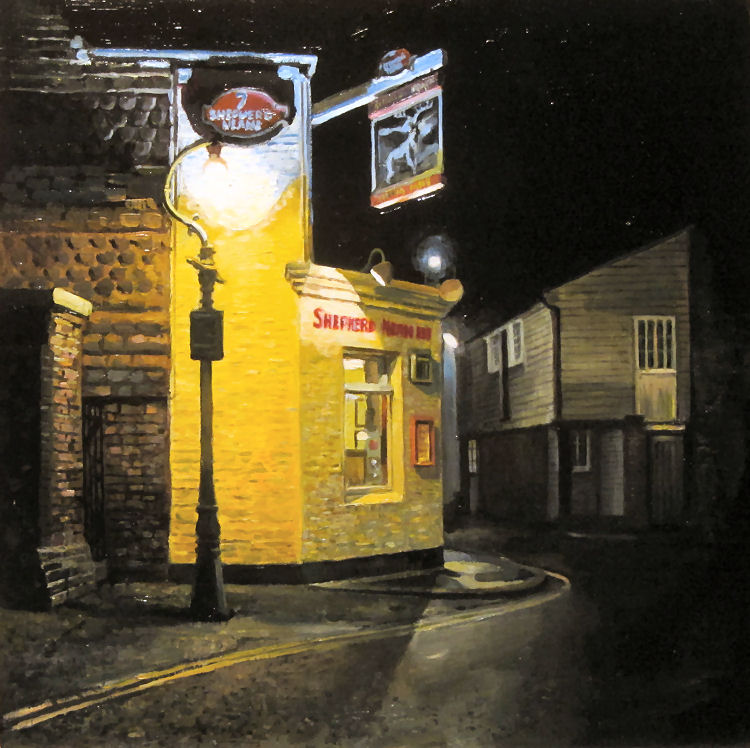
Above painting, 2017, by Jonathan Stewardson.
http://jonathanstewardson.com/ |
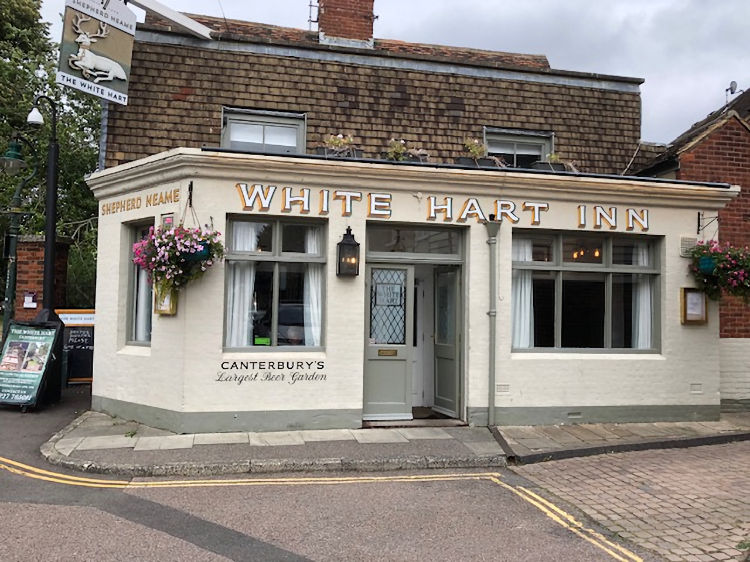 Above photo, 2024, kindly taken and sent by Michael Harris. |
The name of this place used to be called the Chapel Churchyard, the
Church being the long demolished church of St. Mary de Castro, and is shown
on maps dating 1642, very close to where the pub now stands. I have also
seen it addressed as Castle Street, Old Castle Yard and Castle Row.
Built on the ruins of St. Mary's Church on 4th March 1837, where their cellar
was once a mortuary, and still has the body chute for sliding the coffins to
the mortuary below, and it reputed to be
haunted by the spirit of a small boy who was crushed to death by corpses
during the English Civil War in its cellar and upper rooms.
The Inns of Canterbury by Edward Wilmot's,1988, mentions a document, date
circa 1945 that gives the description of clientele at the pub as being "Artisans
and labouring, some miners."
The premises was refurbished in 2011.
|
Kentish Gazette, 4 July, 1806.
DEATH.
Yesterday, Mrs. Howard, wife of Mr. Howard, landlord of the "White
Hart" public-house, Wincheap gate, Canterbury.
|
|
Kentish Gazette 3 August 1819.
Death.
July 28th, suddenly, from a fit of St. Anthony's Fire, (food
poisoning) the wife of Mr. John Wright, of the "White Hart" public
house, Canterbury.
|
|
From the Kent Herald, 1 January 1824.
Dec. 28, in Gas-street, Canterbury, Mrs. Wright, wife of Mr. Wright, late
husband of the "White Hart" public house.
|
|
Kentish Gazette, 21 September 1852.
Thursday. Licensing.
This being the adjourned licensing day, those parties, whose licences
had been suspended, again attended, and after
receiving animadversion for their irregularity of conduct, had their
licences granted, but with a decided caution that if again
complaints were made against them they would not have their licences in
future.
These parties were:- John Stairs, of the "Eight Bells," King Street;
John Noble, "Kentish Arms;"
George Kilner, "City of London;"
John Jordan, "White Heart;"
John Gillis, "Bricklayers' Arms;"
Elizabeth Forbes, "Oddfellows Arms;"
John Murphy, "Carpenter's Arms;"
Richard Wellard, "George and Dragon," Westgate;
Joseph Pentecost, "Royal George;"
and George Crow, "Rose and Crown."
Applications for New Licences.
Thomas Rodgers, of the "Sir Robert Peel" beer shop;
David Tuthwell, "True
Britain;"
and Edward Gordon, "Pine Apple,"
applied
for spirit licences, but which were refused.
|
|
South Eastern Gazette, 1 May, 1860.
Stealing a Watch.
On Friday last a private in the 64th Regt., named Henry Wales, was
charged before the Mayor and W. H. Trimnell, with having stolen a
silver watch, value £2, from the person of Joseph Harris, a navvy.
The prosecutor stated that on the previous Sunday he was in a state
of intoxication, when he lost the watch produced, but where he could
not recollect. At 3 o'clock, when he missed it, he was at the "White
Hart" public-house, Castle-row. A youth named Geo. Brett, residing
in White Horse-lane, informed the Bench that at three o'clock on
Sunday afternoon he saw the prosecutor lying in the lane; prisoner
got him up and took him round the corner into Jewry-lane, where they
both fell down. Witness then went for the police, but on his return
the prisoner took prosecutor away up Lamb-lane. A girl named Fist
saw the prisoner put his hand into prosecutor’s pocket, and take
something out. Sergt-Major Wren, of the 4th Depot Battalion,
informed the bench that the watch produced had been found in a
water-closet in the barracks. The Mayor said that although there was
a good deal of suspicion, the evidence was not clear enough to put
the prisoner upon his trial. He was consequently discharged, and the
watch was given up to the prosecutor.
|
|
From the Kentish Chronicle, 5 May, 1860.
CANTERBURY POLICE COURT. Friday.
(Before the Mayor and W. U. Trimnell, Esq.)
Henry Wales, a soldier belonging to the 64th Regt., was charged with
stealing a watch, the properly of Joseph Harris, an excavator. The
prosecutor was drinking at the "White Hart" on Sunday afternoon. The
prisoner was there also. The prosecutor was not sober at the time; in
fact, he was so much under the influence of liquor as not to know what
he was about; but after leaving the public-house he missed his watch. A
watch, which prosecutor identified as his property, was subsequently
found in a water-closet at the barracks, and the prisoner was
apprehended on suspicion. There was no evidence to show, however, that
the watch had ever even been in the possession of the prisoner, who was
consequently discharged.
|
|
From the Whitstable Times and Herne Bay Herald. 10 February 1900. Price 1d.
WOMAN BURNED TO DEATH AT CANTERBURY.
The City Coroner (Dr. T. S. Johnson.) held an inquest at the “White
Hart,” Worthgate Place, Canterbury, on Monday evening, touching the
death of Louise Holmes, aged 69, a married woman living with her husband
at 7, Worthgate Place. John Holmes, a warehouseman, identified the body as that of his wife.
They had lived at 7, Worthgate Place for about thirty years. The
deceased was a somewhat delicate woman, but had been more so for about
eighteen months. She was in the habit of sitting by the fire in a
certain chair in the evenings. Deceased always liked witness to go out
for a walk after tea, and on Saturday evening at about 8.30 she asked
him to go out. He did so, and when he was coming through the Dane John
on his way home, about eleven o'clock, his young man came running up and
informed him that his wife was on fire. Mr. Prentice got to the house
soon after witness arrived. Deceased was being attended to, witness was
not allowed it go into the room. Deceased asked “if her Johnnie was in”
meaning witness, but was unable to state how the accident occurred. The
deceased had complained of pains in her legs and back, and Dr. Sworn had
attended her for about a fortnight or three weeks. When witness left the
deceased at 8. 30 she was in her usual state of health. She was sitting
in her usual chair and was fully dressed. It was a coal fire. John Holmes, son of last witness, stated that be was a warehouseman in
the employ of Messrs. F. Finn and Sons. He came home at eight o'clock on
Saturday evening as be was not well. He sat by the fire till 9.30, when
be went to bed. His mother was then sitting by the fire with a Mrs.
Hollands. At about 10.30 or thereabouts he heard his mother screaming.
Witness went into her bedroom as he thought she was very likely there,
but as she was not he went downstairs. There be found the deceased with
her head against the bars of the fire-place. She was unconscious and
could not get away. The deceased dress was also ignited. Witness pulled
his mother away from the fire and put her on the floor and tried to
smother the flames with some clothes. He was, however, unsuccessful, and
had to call in some neighbours before the flames were extinguished. He
went for Mr. Prentice, who soon arrived at the house. Emma Potts, wife of Harry Potts, living at Castle Row, and a neighbour
of deceased, stated that at about eleven o'clock on the night in
question she was coming through the churchyard when she heard someone
say that a woman was on fire. She ran to the house and found the
deceased on the floor. The deceased's clothes were cut away and she was
carried into the front room. Witness waited till Mr. Prentice arrived
and then stayed till a quarter to three on Sunday morning, when the
deceased expired. Witness had known the deceased for about sixteen
years. Mr. Z. Prentice, surgeon, deposed that he was celled to see the decease
at 11.30 on Saturday night. He found her lying on a sofa. She had been
undressed and was wrapped in blankets. She was in great pain and was
suffering from burns. She was burned about the head and neck, front and
back of chest, face, both arms, especially the right, and the lower part
of her body. Witness dressed the rounds. She was unable to make any
statement as to how the accident occurred. The deceased passed away at
about a quarter to three on Sunday morning. Death was caused by burns
and subsequent shock. The Coroner briefly summed up, and the jury returned a verdict of
“Accidental Death.” |
|
Dover Express 16th July 1948.
CLUE OF A WAGES SLIP.
Two Snowdown Colliery miners, James T. Parkinson (28), of 6 Old Park,
Aylesham, and John C. Morris (38) of Zealand Road, Canterbury, at
Canterbury Quarter Sessions on Saturday, pleaded guilty to being
concerned together in breaking and entering the booking office at
Canterbury East Station about 16th April and stealing a trunk containing
clothing and an ATS girl’s kitbag and suitcase, also containing clothing
etc., and 3s 10d from a platform ticket machine; and breaking and
entering Cadbury’s depot at Canterbury East on May 15th and stealing
chocolates and cocoa to the value of 10s 7d.
Both also admitted being concerned in breaking into the “White Hart”,
Canterbury and stealing £4 5s from the till and breaking and entering 3 Worthgate Place, Canterbury, and stealing about £4 5s belonging to
Arthur Shrubsole. Parkinson further admitted breaking into the
“Dolphin”, Canterbury, and stealing money and breaking into
"Aylesham
Working Mens’ Club" and stealing bottles of spirits and cash to the total
value of £39 14s 5d.
Mr. J. S. Daniel, prosecuting, said that it was due to the vigilance of PC
Hutchings that a wages slip was found beneath the open window at
Cadbury’s and all these cases were unearthed. The paper led to Morris
and on to Parkinson and, in each of their homes, some of the stolen
property was found. Morris admitted that he had “done the job” after he
had had some beer.
The Recorder (Mr. Eric Neve KC) said it was a very commendable piece of
work on the part of the constable.
DC Packman said Parkinson was before a juvenile court on four occasions
for larceny and shopbreaking and had been sent to an approved school. He
served in the Forces and in the Palestine Police and was discharged with
a very good character. He had earned up to £11 weekly at the colliery
and was married with three children. Morris had no previous convictions
and had been at Snowdown since 1943, was an excellent worker and earned
about £10 weekly. He had seven children.
The Probation Officer reported that Parkinson was a good worker and had
been in no trouble since 1936. He had stated that he was off work and
was short of funds. He did not seem to realise his serious position.
Morris had looked after his children well, but was of the type easily
swayed after a few drinks. He had had a really bad fright over that
case.
The Recorder asked Parkinson if he could give any reason why he should
not go to prison for twelve months, and the prisoner replied that, if he
went to prison, his wife and children would be the obvious sufferers.
Morris attributed the offences to stoppages and strikes which did not
enable him to provide for his wife and family.
He was told to watch his step. The Court would take the lenient course
of binding him over for three years.
The Recorder told Parkinson that they were going to make him care. He
should have been sent to prison for a long time, but he would be
remanded on bail until October, when the course then taken would depend
on the reports on him that the Court received.
|
|
From
http://www.ghostpubs.com accessed 17 June 2015.
HAUNTED.
Although it now presents as a modern pub, the building has history
over two centuries. It is on the ruins of St Mary's church and the small
car park adjacent to the "White Hart" was at one time a graveyard. The
tombstones from that period now line up against one wall of the "White
Hart." The beer cellars of the pub were once employed as a temporary
mortuary. There was a body chute from ground level. On another side of
the "White Hart" is an old Roman burial ground. It comes as no surprise
that it exhibits ghostly manifestations. These include the ghosts of
yesteryear. Employees working here have heard moaning and odd black
shapes, appearing as figures. Other witnesses have reported that the
ghosts are men and women wearing Victorian style clothing of suits and
dresses or grey shrouds.
|
LICENSEE LIST
Howard Mr 1806+
WRIGHT John 1819-24+
 (Old Castle Yard)
(Old Castle Yard)
HARVEY George 1837-38+
 
JENNINGS William 1847+

JORDAN John 1851-62
(age 45 in 1861 ) )
  
JORDAN Ann (widow) 1862+

HOLMES J 1868+

HOLMES Harriet 1881+ (widow age 66 in 1881 ) )
WATTS Henry Stephen 1891+
 (brother-in-law of Anderson)
(brother-in-law of Anderson)
ANDERSON Frederick 1897+

BURTON Charles 1901-03+
  
LEE Henry 1913+

EMERY Frederick C 1922+

EVANS William P 1930+

NIGHTINGALE Arthur 1938+

???? May & Bob 1985+
SHORT Mr & Mrs W K 1988+

BUTLER Mr Mat 2012+
https://pubwiki.co.uk/WhiteHart.shtml
 Stapleton's
Guide 1838 Stapleton's
Guide 1838
 From Bagshaw Directory 1847 From Bagshaw Directory 1847
 From Melville's Directory 1858 From Melville's Directory 1858
 From the Post Office Directory 1862 From the Post Office Directory 1862
 Greens
Canterbury Directory 1868 Greens
Canterbury Directory 1868
 From the Post Office Directory 1874 From the Post Office Directory 1874
 From the Post Office Directory 1882 From the Post Office Directory 1882
 From the Post Office Directory 1891 From the Post Office Directory 1891
 From the Post Office Directory 1903 From the Post Office Directory 1903
 From the Kelly's Directory 1903 From the Kelly's Directory 1903
 From the Post Office Directory 1913 From the Post Office Directory 1913
 From the Post Office Directory 1922 From the Post Office Directory 1922
 From the Post Office Directory 1930 From the Post Office Directory 1930
 From the Post Office Directory 1938 From the Post Office Directory 1938
 Inns of Canterbury
by Edward Wilmot, 1988 Inns of Canterbury
by Edward Wilmot, 1988
|















